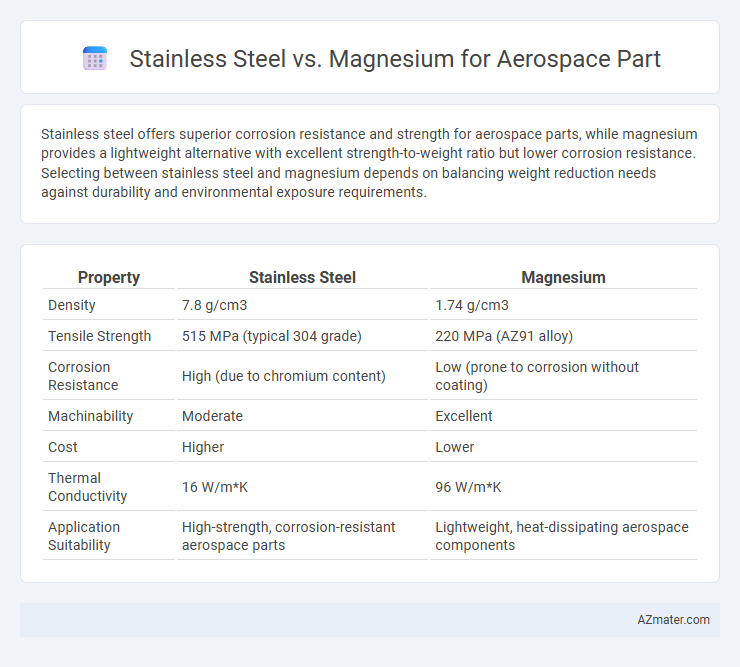Stainless steel offers superior corrosion resistance and strength for aerospace parts, while magnesium provides a lightweight alternative with excellent strength-to-weight ratio but lower corrosion resistance. Selecting between stainless steel and magnesium depends on balancing weight reduction needs against durability and environmental exposure requirements.
Table of Comparison
| Property | Stainless Steel | Magnesium |
|---|---|---|
| Density | 7.8 g/cm3 | 1.74 g/cm3 |
| Tensile Strength | 515 MPa (typical 304 grade) | 220 MPa (AZ91 alloy) |
| Corrosion Resistance | High (due to chromium content) | Low (prone to corrosion without coating) |
| Machinability | Moderate | Excellent |
| Cost | Higher | Lower |
| Thermal Conductivity | 16 W/m*K | 96 W/m*K |
| Application Suitability | High-strength, corrosion-resistant aerospace parts | Lightweight, heat-dissipating aerospace components |
Introduction to Aerospace Material Selection
Stainless steel offers exceptional corrosion resistance and high tensile strength, making it suitable for aerospace components requiring durability under extreme conditions. Magnesium, known for its lightweight properties and excellent strength-to-weight ratio, is favored in aerospace applications aimed at reducing overall weight and improving fuel efficiency. Selecting between stainless steel and magnesium hinges on balancing mechanical performance, weight constraints, corrosion resistance, and cost-effectiveness in aerospace material engineering.
Overview of Stainless Steel in Aerospace Applications
Stainless steel is widely used in aerospace applications due to its exceptional corrosion resistance, high strength-to-weight ratio, and excellent durability under extreme environmental conditions. Its ability to withstand high temperatures and mechanical stress makes it ideal for structural components, engine parts, and fasteners in aircraft manufacturing. Despite being heavier than magnesium, stainless steel's superior fatigue resistance and longevity ensure safety and reliability in critical aerospace systems.
Advantages of Magnesium for Aerospace Components
Magnesium offers a superior strength-to-weight ratio compared to stainless steel, making it ideal for aerospace components where weight reduction enhances fuel efficiency and performance. Its excellent machinability and vibration damping properties contribute to improved structural integrity and reduced operational noise. Furthermore, magnesium's natural resistance to corrosion, when properly treated, ensures durability in harsh aerospace environments.
Mechanical Properties: Strength and Durability Comparison
Stainless steel offers high tensile strength and excellent corrosion resistance, making it ideal for aerospace components requiring durability under extreme conditions. Magnesium provides a superior strength-to-weight ratio and exceptional lightweight properties but has lower fatigue resistance and is more prone to environmental degradation. For aerospace applications demanding a balance between strength and weight savings, stainless steel is favored for critical load-bearing parts, while magnesium is preferred where reducing mass is paramount.
Weight Considerations: Magnesium vs Stainless Steel
Magnesium alloys offer a significant weight advantage over stainless steel, with a density of approximately 1.74 g/cm3 compared to stainless steel's 7.9 g/cm3, making magnesium nearly 78% lighter. This substantial reduction in weight directly contributes to improved fuel efficiency and payload capacity in aerospace applications. Despite its lower density, magnesium's strength-to-weight ratio enables it to meet structural requirements while minimizing overall component mass.
Corrosion Resistance in Aerospace Environments
Stainless steel exhibits superior corrosion resistance in aerospace environments due to its chromium-rich oxide layer that protects against oxidation and chemical exposure, essential for high-altitude and marine airframes. Magnesium, although lightweight and beneficial for weight reduction, is significantly more susceptible to corrosion, especially in saltwater and acidic conditions, necessitating protective coatings and regular maintenance. The choice between stainless steel and magnesium often balances corrosion resistance with weight considerations critical for aerospace performance and longevity.
Manufacturability and Machinability Differences
Stainless steel offers superior corrosion resistance and high strength but presents challenges in machinability due to its hardness and work hardening properties, often requiring specialized cutting tools and slower feed rates in aerospace part manufacturing. Magnesium, valued for its light weight and excellent machinability, allows faster cutting speeds and easier shaping, reducing manufacturing time and cost, though it demands careful handling to prevent flammability risks during machining. Aerospace manufacturers must balance the durability and weight savings of magnesium against the robustness and higher machining complexity of stainless steel when selecting materials for critical components.
Cost Analysis and Economic Impact
Stainless steel offers superior strength and corrosion resistance, but its higher density results in increased weight and fuel consumption, raising operational costs in aerospace applications. Magnesium's lightweight nature significantly reduces aircraft weight, improving fuel efficiency and lowering emissions, though its higher material and manufacturing costs can impact initial expenditures. A comprehensive cost analysis must consider lifecycle expenses, including maintenance and fuel savings, where magnesium often provides economic advantages despite upfront investment.
Safety and Performance Factors
Stainless steel offers superior corrosion resistance and high tensile strength, ensuring durability and safety under extreme aerospace operating conditions. Magnesium is significantly lighter, enhancing fuel efficiency and performance but requires advanced protective coatings to mitigate its susceptibility to corrosion and fatigue. Balancing weight reduction and structural integrity is critical, making material selection dependent on specific aerospace safety standards and performance requirements.
Conclusion: Choosing the Right Material for Aerospace Parts
Stainless steel offers exceptional strength, corrosion resistance, and durability, making it ideal for aerospace parts exposed to high stress and harsh environments. Magnesium provides significant weight savings and good machinability, crucial for reducing overall aircraft weight and improving fuel efficiency. Selecting the right material depends on balancing mechanical performance, weight considerations, and specific aerospace application requirements to optimize safety and efficiency.

Infographic: Stainless steel vs Magnesium for Aerospace part
 azmater.com
azmater.com